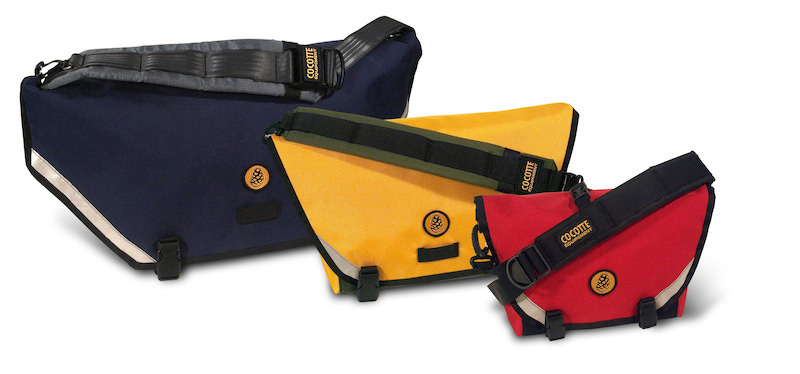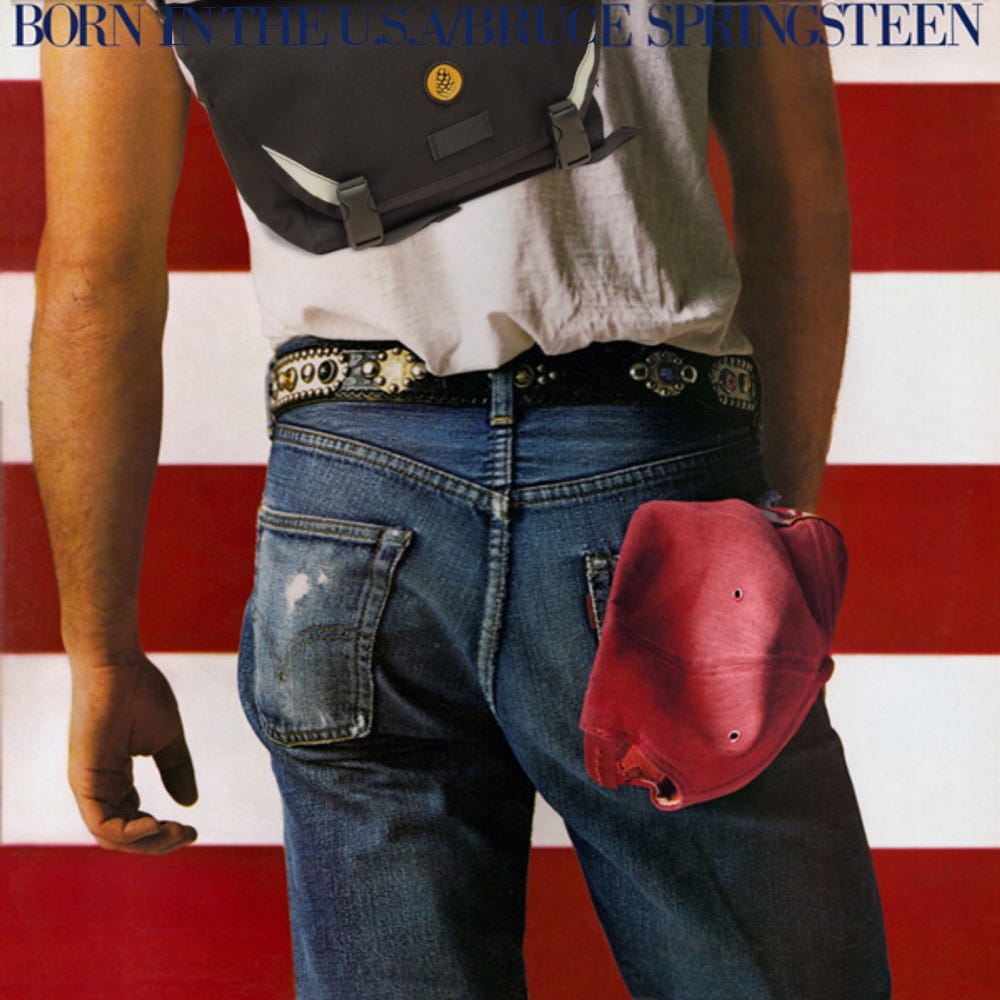Cocotte, the Montreal Birkin
Katia Lo Innes joins the newsletter to talk love, lust, and messenger bags.
Marc: Last week I covered the Ciele hat, the running cap ubiquitous among Montreal’s sporty population. The hat itself provided no mystery with its clear branding, but its locally sourced popularity gave a lot to chew on. But the Ciele GOcap is not the only accessory that dominates Montreal.
Katia: Much like the Ciele hat, the Cocotte bag seems to spring from an organic, word-of-mouth popularity. I think it’s suffice to say that Cocotte bags have taken a life of their own, becoming the de-facto “it bag” for not just urban cyclists, but for all those in Montreal with a finger on the pulse. Cocotte has been around for a few decades now, long being a staple for bike messengers.1
Marc: But the story of Cocotte bags goes a lot deeper, as they are a phenomenon much more deeply rooted in the psyche of Montrealers and Montrealers only.

Katia: I totally agree. In the recent decade, Cocottes have infiltrated a larger market of casual consumers, so owning a Cocotte in Montreal isn’t unusual per say; rather, it’s indicative of a person’s ability to not only scope out trends, but good quality products. My friend Julia (a.k.a. @juicegirl44) tweeted her confusion about the Cocotte bag phenomenon, and then a month later told me she bought the Cocotte Fred for herself. Allegedly, it is an amazing bag.
Marc: It’s absurd how technical these bags are. They’re handmade in Cocotte’s Plateau workshop. Empty, the bag weighs 1.48 kilograms and folds in on itself to be about half the width of a Nalgene. Unfolded, the 1000D Codura nylon sides swell to contain 32 liters or about 32 Nalgenes by volume.

All Cocotte messenger bags feature a sternum strap to prevent to bag from sliding around on your back. Further, they compress to perfectly fit their contents, keeping the bag as close to your back as possible. The padded shoulder strap is easily adjustable and fast, so the bag can go from snugly slung on your back to in your hands in three seconds. They are just truly excellent messenger bags.
But before I knew about the specs, all I knew was that this bag was everywhere. I have no recollection of when I started seeing them. It feels like at some point I had a Berenstein/Berenstain drift between worlds and they were just there. I guess my experience with Cocottes is a prime example of the Baader-Meinhoff frequency illusion.2 I had no idea what they were called or what the deal with them was, but sighting after sighting made them familiar in an odd, tell-me-you-see-them-too way. I mistook the subtle pinecone logo for an acorn and spent hours googling “acorn bag,” which brought me to another company—literally called Acorn Bag—which are uglier and probably for Yuppies.

Katia: My anagnorisis was in late June when I got set up on a date and decided to actually follow through with it.3 My said date was sporting what I can now identify as a Cocotte Fred messenger bag; I had always seen the bag on the street, but I had never encountered it in such an intimate setting. From up close, I could see the signature reflective tape and yellow logo. Little did I know how this iconography would come to disturb me. The date ultimately amounted to nothing; the effect that his biking bag had on me was long-lasting.
After that date, the bag seemed to haunt me. I went on another middling date. He had a Cocotte bag; I felt crazy. Disturbingly, I also noticed it hanging from my pseudo-friends-with-benefits’ closet door. That summer, I was left wondering what the prevalence of Cocotte bags meant about the people I was dating, or what it meant about my own personal choices. I became convinced the Cocotte bags were some sort of cosmic sign. I bombarded my friends with my ramblings about the bags’ pervasiveness and they agreed: indeed, it appeared everywhere you turned. We dubbed it thereafter “The Bag.” Anyways, I digress.
Marc: That’s haunting. It seems you’re not the only one whose sex life has been touched by “The Bag”:
I asked Sloane to elaborate on her above tweet, and she offered the following:
For me, the sex appeal of the cocotte bag has a lot to do with who I associate them with— bike couriers, anarchist students, hot professionals. They kind of function as a cross-demographic signifier of a certain urbane sexiness— sleek, speedy, opposed to the drudgery of suburban car culture and corporate briefcases.
The Cocotte wearer is far too cool to subject themselves to the torture and humiliation that is driving and parking a car in Montreal. They recognize the aesthetic and functional superiority of biking, and they’ve outfitted themselves with the best and most esoteric gear for the job.4 Competence is hot, and that’s exactly what the Cocotte wearer is. They are blue-jean sexy. They are young Bruce Springsteen sexy. I think this explains their popularity among university students with bouldering gym memberships.
Katia: That’s so true—the Cocotte bag eschews the corporate sterility that has unfortunately overrun the average contemporary subject’s wardrobe.5 I hesitate to call anything “authentic,” but there seems to be a genuine earnestness behind how Cocottes are made and branded, down to their kitschy, out-of-date website.
The target market for Cocotte is basically everyone. Although it seems to have caught the attention of a very locally specific 20-something, it has also captured the hearts of vibey teens, hot Laurier East parents, and pixie cut professionals—reaching an audience well beyond its initial intended demographic of grimy bike couriers.
In a sense, Cocotte’s popularity may just be a part of the continuing evolution of outdoor normcore and tactical gear into casual wardrobes and streetwear.6 One could make a convincing argument that this is a way of exploiting a working-class wardrobe.
Marc: For sure; the workwear trend has been strong for a minute now but feels particularly at home in Montreal. We’ve made chefs and the like rock stars, and so everyone wants to look like they work standing up. Vintage Levi’s and Carhartt’s are the crown jewels of many a second-hand shop. People are very happy to pay a premium for double-knee pants that someone else has broken in. Bike couriers fit the “hot service worker” bill, so the Fred bag’s popularity very well may be more blue-collar stolen valour.
Katia: Or, it could be an organic fashion phenomenon dictated by the masses. It could also be a resurgent appreciation for well-crafted, high-quality goods. Either way, dressing this way (e.g. sporting a Cocotte) is a way of letting people know that you are always on the move and you are making a point of looking good while doing it. In Montreal, it’s both not a status symbol and very much a status symbol. I think Julia summed up this duality nicely with this anecdote:
A few months ago at a dinner this guy went on a rant about how he would buy a Cocotte bag if only they weren’t so popular, as he wants to be very unique and cool. He then went on to say that maybe if he moved to B.C. he would buy a Cocotte bag, as not many people have them there so he would therefore seem interesting. After his little speech, I pulled out my own beautiful Cocotte bag complete with some sewn on matching patches and everyone swooned.
A Cocotte is ubiquitous with the location in which it emerged from, and I think this is to its benefit. Buying a Cocotte isn’t mindlessly conforming to a trend: it is to actively engage in the contemporary moment.
Marc: Totally. It’s a completely homegrown phenomenon, another entry on the long list of Québec oddities.
Katia: It’s an oddity that I am willing and ready to embrace. I think after years of being terrorized by Fjallraven Kånkens and Herschels, I am glad to see the masses embracing daypacks that are both elegant and functional. Beyond being an accessory to reduce one’s entire identity to, I prefer to see these bags as part of a greater cultural ecosystem, one that prioritizes Montreal’s eccentricities and makes the best of them.
Marc: Exactly. In no other city could the Cocotte Fred be an “it-bag”. Take New York for example: I think of the Hermès Birkin, I think of the Telfar shopping bag. These bags convey elegance and luxury with their leather and vegan-leather construction, respectively. They are beautiful and chic. The Cocotte Fred is also beautiful and chic, but it’s made of super-tough nylon. It’s the bag of a city whose inhabitants live in factories-turned-artist-studios-turned-lofts. It’s Montreal’s Birkin, and it couldn’t be any other way.
It even featured prominently in the classic piece of Quebecois lesbian bike messenger cinema 2 Seconds (1998), hanging over the backs of its cycling protagonists.
The Baader–Meinhof phenomenon, is a cognitive bias in which, after noticing something for the first time, there is a tendency to notice it more often, leading someone to believe that it has a high frequency (a form of selection bias). It occurs when increased awareness of something creates the illusion that it is appearing more often. — Wikipedia
Anagnorisis refers to a moment of insight in a story’s plot in which a character, usually the protagonist, shifts from ignorance to awareness.— LiteraryDevices.net
Bonus quote from Julia on the psychology of a Cocotte wearer: “If you still adore your Blundstones, don’t care who sees you drinking overpriced kombucha, will never truly get over flannels and fatherly fashion […] and want to defeat your pretentious enemies at dinner parties, this is the bag for you.”
Think: the Blundstone craze in the frigid early 2010s; Teva’s as fashionable footwear; the proliferation of Carhartt hoodies as both work clothes and the hot outfit to wear attending a gig.










